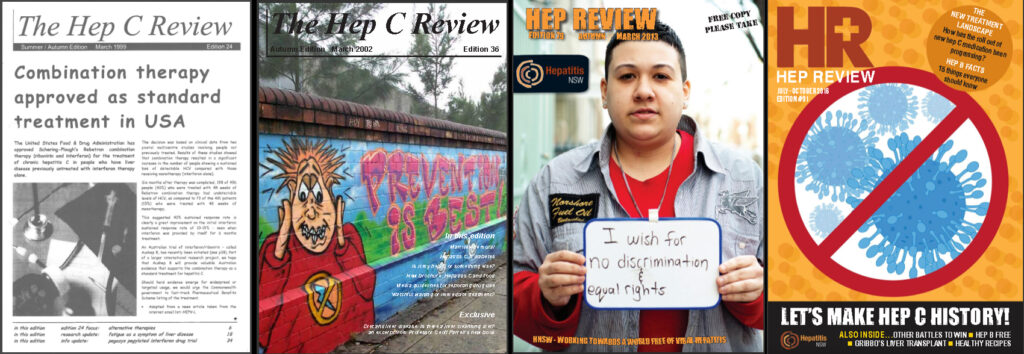The Champion #102 – December 2021
This issue:
- Sinead Sheils wins 2021 Hepatitis NSW Cheryl Burman Award
- Hepatitis NSW has turned 30 years-old!
- 2021 Audrey Lamb Community Forum and Annual General Meeting
- Celebrating hep B stories and lived experiences

Sinead Sheils wins 2021 Hepatitis NSW Cheryl Burman Award
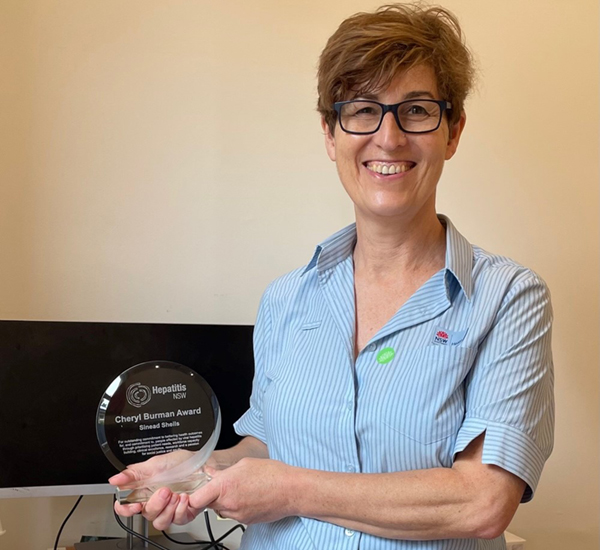
Sinead Sheils, a hepatology Nurse Practitioner with Sydney Local Health District, is the recipient of Hepatitis NSW’s 2021 Cheryl Burman Award. The Cheryl Burman Award acknowledges outstanding work or achievements by an individual or team in NSW within the viral hepatitis sector.
The Cheryl Burman Award this year recognises Sinead Sheils for her substantial contribution to improving the quality of life of people living with viral hepatitis.
Sinead’s clinical approach has resulted in great, positives outcomes for all stakeholders, especially clients. As a Hepatology Nurse Practitioner at the Royal Prince Alfred Hospital, she has built workforce capacity and initiated evidence-based best practice.
Central to Sinead’s successes is her passion for working within a social justice and equity framework. Her passion and commitment for bettering the health outcomes for those most vulnerable has been longstanding.
Sinead’s commitment and contribution to testing and treating hepatitis C exceeds twenty years of nursing service. During this time, she also fulfilled roles as Clinical Nurse Specialist and Clinical Nurse Consultant. In 2015, Sinead completed her Master of Nursing (Nurse Practitioner) at the University of Sydney
Sinead’s collaborative approach to tackling viral hepatitis is well recognised. She has great rapport with clinical, non-clinical and external stakeholders alike; frequently negotiating and adapting her clinical activities, ensuring the greatest outcomes for all stakeholders, including clients.
This approach has been demonstrated, for example, through the roll out of ‘Blood-Borne Virus (BBV) Blitzes’. The Blitz model provides opportunistic HIV, hep B, and hep C testing to the most vulnerable using an outreach capacity as a way of mitigating many of the challenges experienced by those wanting to access testing.
Other benefits include building rapport in a setting that is familiar and safe to the community; eliminating concerns regarding stigma and privacy experienced when accessing conventional health services.
The model is holistic, offering peer engagement, health promotion, testing and, if required, treatment initiation. As a Nurse Practitioner, Sinead is well placed to dispense treatment on-site, further promoting accessibility and acceptability. Anecdotally, those clients who have successfully completed their treatment through this process, have reported that accessibility to dispensing via outreach was instrumental to not just their completion of treatment but also in being cured of hepatitis C.
Hepatitis NSW congratulates Sinead. By any measure, she is a very worthy recipient of this prestigious award, demonstrating strong leadership and initiative in the sector. Sinead joins a growing list of leaders and champions of the NSW viral hepatitis community very much in the mould of Cheryl herself.
- For a list of past winners >>>CLICK HERE
Hepatitis NSW has turned 30 years-old!
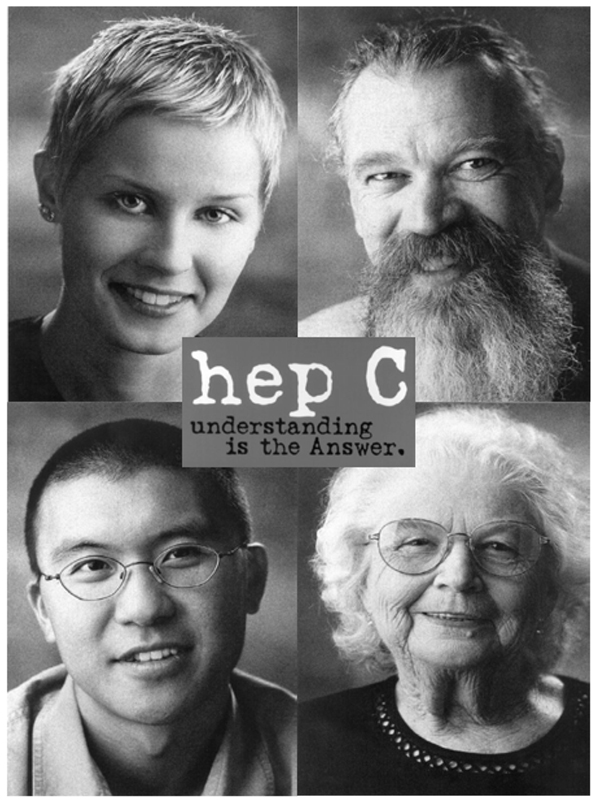
Hepatitis NSW passed a major milestone in November 2021, notching up thirty years of service and support to communities affected by viral hepatitis.
Please celebrate with us!: Tuesday 14 December from 6:30pm | Zoom >>>MORE INFO
A short history of Hepatitis NSW
The beginning
Previously known only as non-A-non-B-hepatitis, the hep C virus was identified in 1989. While this began a new era in scientific understanding of the virus, the people affected by it faced confusion and ignorance about their condition. With community information and support clearly needed, a patient support group – assisted by Prof. Geoffrey Farrell of Westmead Hospital, and led by Audrey Lamb – started in November 1991.
Known initially as the NSW Hepatitis C Support Group, we grew to become the Hepatitis C Council of NSW and, now, Hepatitis NSW.
A toll-free 1800 support line, with a state-wide network of volunteer telephone counsellors, was established. The first hep C information pack was also produced and posted to support line callers and health care professionals. Advocacy activities, to bring greater awareness and reduce stigma, began in earnest.
To communicate directly with the community, The Hepatitis C Support Group Newsletter was published May 21, 1992 and mailed out to subscribers. The first article of this four-page edition proclaimed, in part:
The hepatitis C support group is off and running!
We have had an excellent response to publicity, and the number of telephone calls received indicate a genuine need for our group. In spite of a few hiccups with our answering system, there has been an almost overwhelming number of requests for help, with over 70 inquiries.
National development
With similar information and support needs existing Australia-wide, we incorporated as a registered charity – the Australian Hepatitis C Support Group – in 1993. While remaining committed to client support services, the group increasingly began to address public and peer education and national issues, including access to interferon treatment and social security pensions. Networking with peer health and welfare based agencies also increased.
However, applications for Federal Government funding were rejected and the group could not function on a national level. In July 1994, the Australian Hepatitis C Support Group reformed as the Hepatitis C Council of NSW, moving to its first office at Belmore Street, Surry Hills. The federal effort was not in vain however, as a national and other state and territory hep C organisations were soon to form.
Our newsletter – growing in subscribers, content and size – became The Hep C Review with edition #9 in September 1994 – with 20 pages packed with letters, reports, information and support.
NSW consolidation
In 1994, the NSW Health Department funded us for the ongoing provision of information and support services – marking the start of a shared commitment to address hep C needs across the state. A NSW Hepatitis C Taskforce was convened to identify gaps in hep C health care and to propose a response. The Council was invited to be a member of this taskforce, along with other community-based groups and government departments.
In December 1994, we relocated to more suitable office accommodation in Crown Street, Surry Hills. Provision of extra funding from NSW Health assisted in the expansion of information and support services. We brought the Hepatitis Helpline in-house – formalising the volunteer training program, and expanding the hours of operation.
From 1995 to 2000 Hepatitis NSW represented hep-affected communities through our membership of various NSW and national advisory groups, consultation committees and projects. In 1998-99 we played a major role in the NSW Parliament’s Standing Committee on Social Issues Inquiry into hep C – Hepatitis C: The Neglected Epidemic. This bipartisan Inquiry report was tabled in NSW’s Legislative Council in November 1998, finding that the social impact of hep C was profound and touched every facet of community life.
During 1999 and 2000 we made major contributions to the development of the first NSW, and first National, Hepatitis C Strategies. A range of welcome publicly funded hep C projects enabled NSW to work towards further reducing the impact of hep C on those it affects. We piloted and developed an innovative health care worker education strategy, enhancing the capacity of health services to better meet the needs of people living with or at risk from hep C.
A new era of service delivery
Hepatitis NSW’s role in the planning and operation, through a greatly expanded Hepatitis Helpline, of the world’s first mass media hep C public awareness campaign in March 2000 was important in ensuring community input remained at the forefront of the public health partnership response to hep C.
We worked in close partnership with the NSW Anti-Discrimination Board in the world’s first inquiry into hep-related discrimination. The resulting report – C Change – informed ongoing access and equity improvements within the health workforce, general workplace, and wider community.
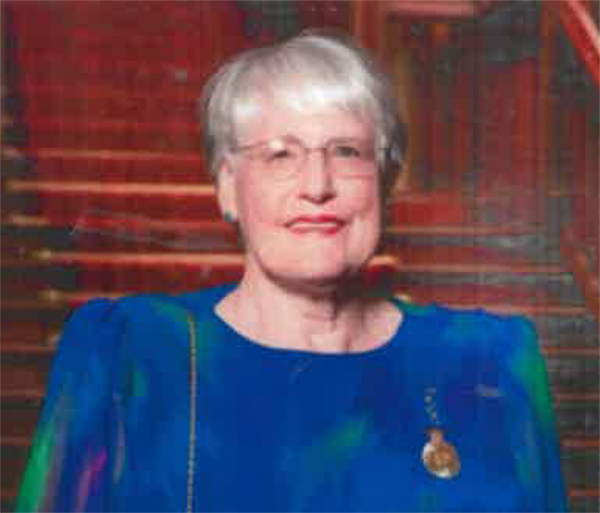
Funding increments led, in early 2001, to the establishment of our Heplink hep C related healthcare worker network, and C-een & Heard positive speakers service. Soon afterwards, in collaboration with the NSW Department of Corrective Services, we established the Prisons Hepatitis Helpline.
To foster better peer support, we launched the Hep-C-Australasia internet forum in September 2003. Then, in June 2005, our Media Speakers Service was launched. This project involved recruiting people living with hep C who were prepared to tell of their experience on television and radio and in print media. The volunteers were provided with media training and professional support.
In March 2007 we launched Hep Connect, a peer support program enabling people to speak by phone with trained volunteers who have experiences of living with hep C, including treatment (which was still interferon based).
Our first president, Audrey Lamb, was awarded The Order of Australia Medal in June 2007, in recognition of her work for hep C affected communities (pictured right, with her OAM.)
Several key projects were initiated through 2009. Most notably, working in collaboration with the Aboriginal Health & Medical Research Council, lllbijerri Aboriginal & Torres Strait Islander Theatre and NSW Health, we supported and promoted the Chopped Liver tour across NSW. This health promotion stage drama took hep C info into many Aboriginal communities.
Transmission Magazine was also launched in 2009 – a magazine with a comic strip format that delivered hep C info in an easy-read style.
We changed our name to Hepatitis NSW towards the end of 2009, reflecting our desire to also focus on other forms of viral hepatitis, most notably hepatitis B. A very different virus which could also cause significant liver damage, hep B was impacting Aboriginal and Torres Strait Islander peoples, and many migrant communities in NSW. As part of this shift in focus, our newsletter became The Hep Review in March 2010, with edition #68 – continuing strongly to July 2016, with edition #91 being the last one published.
Our third decade
After many years, and sadly too many people passing away from hep C related illness, game-changing new direct-acting antiviral treatments were developed in the early 2010s. Although they remained experimental and on the horizon for several years, they offered significant hope to the tens of thousands of Australians living with hep C. Not only were they oral, they reportedly had minimal side-effects and a very high success rate – the days of interferon treatment looked to be soon over. Unfortunately, the reputedly astronomical price – per tablet – cast doubt that these literal cures would ever be available to all but the sickest (or richest) people. Our peer based advocacy campaign C-me and other lobbying efforts were undertaken to ensure equal access to the hep C DAAs for all Australians. Our The Champion email newsletter was launched in March 2013 for this very purpose.
“Our 20 Asks” – a Hepatitis NSW campaign manifesto – was published detailing requests of both government and the wider community for improvements to treatment, care and prevention – was released.
In late 2015, we received the great news that the Commonwealth government would list some of the hep C DAAs on the Pharmaceutical Benefits Scheme (PBS) – available via Medicare to all Australians over 18. At last, people could finally access the three month treatments. Importantly, access was provided regardless of degree of liver damage (cirrhosis, fibrosis or not); whether the person was currently in prison; whether a person was currently injecting or had ever injected drugs. It was a great victory, and from March 1, 2016 two DAAs were not only available, they could also be dispensed through general practitioners. Thousands were treated and cured in the first year.
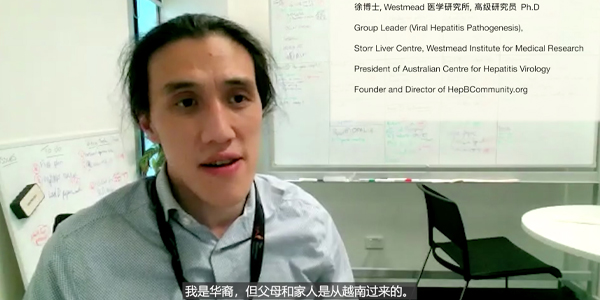
Our focus shifted to ensuring people in the community, and clinicians, understood the hep C DAAs and could be supported through the process of testing, treatment and cure. Unexpectedly at first, but obvious in hindsight, it soon became clear that many people, for any variety of understandable reasons, were unaware of the treatment or unwilling to engage healthcare professionals to start the treatment. As such, we have been involved in many efforts to overcome these gaps in awareness and to improve the experience of engaging with the health system. Chief among this has been our ongoing Hep C state-wide communication campaign, presently in its fourth version as HEP CURED. Transmission Magazine, changed its name to Tx! MAG (Tx=treatment) to also reflect the new focus of efforts.
There has been much work in hepatitis B too. With Commonwealth government funding via Hepatitis Australia, we could establish in September 2016 two project officer positions to work with Korean and Mandarin speaking Chinese communities in NSW. Although the funding ended after two years we have retained these positions and fantastic in-language culturally appropriate work continues in this area. Videos, featuring people willing to talk about and share their experience with hep B, have been produced in-language or with in-language subtitle (screenshot of video featuring Dr Thomas Tu, right). We have also published an in-language Korean/Chinese resources and hep B website – hepB.org.au – explaining the need for regular testing for people living with hep B, and treatment, if necessary. We have also published hep B focused editions of Tx1 MAG for Aboriginal and Torres Strait Islander peoples. There is still much to be done to raise the profile of this virus – which affects one in every one hundred Australians – with governments and clinicians, so that more action can be taken and care provided.
There have been countless activities undertaken by Hepatitis NSW across the last ten years – with much work with people in prison, peer engagement and support, lived experience speakers, collaborations with Local Health Districts and prison settings across the state, partnerships with stakeholders and community organisations, adoption of new technologies and new communication channels… and much, much more.
At the heart of all we have done – over the course of thirty years – has been hundreds of people including staff, peer workers, volunteers, members and supporters, donors and funders – all working with our community towards the goals of eliminating hepatitis C and hepatitis B. Maybe, by the time Hepatitis NSW turns 40, we can say those goals have been met.
A few historical links
- Hep Review newsletter archive – editions 1-50 >>> CLICK HERE
- Hep Review newsletter archive – editions 60-91 >>> CLICK HERE
- Transmission/Tx! MAG archive – editions 1 to 38 >>> CLICK HERE
- Hep C DAAs – Timeline to Success >>> CLICK HERE
2021 Audrey Lamb Community Forum and Annual General Meeting
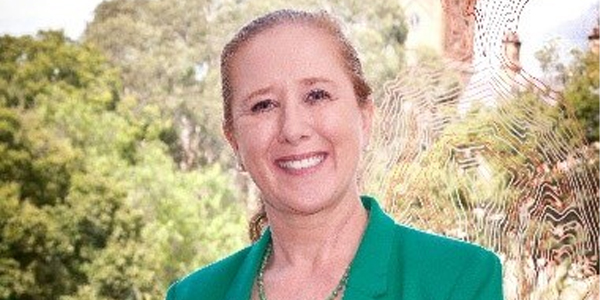
The Hepatitis NSW 2021 Audrey Lamb Community Forum, including the Annual General Meeting was held on Thursday, 25 November. This year, as with so many events held in 2021, the event was again conducted fully online, via Zoom. With a better grasp of the digital platform this year, the event ran even more smoothly, and was well attended.
Audrey Lamb Community Forum
Following a warm Welcome to Country by Rowena Welsh-Jarrett from the Metropolitan Aboriginal Land Council, this year’s Audrey Lamb Forum presentation featured Assoc. Prof. Simone Strasser (pictured), in conversation with Hepatitis NSW CEO, Steven Drew. Simone, is a well-known and highly regarded hepatologist and gastroenterologist with many years of experience. The theme of the discussion was whether the recent COVID pandemic had potentially derailed State and Commonwealth viral hepatitis elimination goals. The Forum was recorded and we hope to have it available to view in early 2022.
Annual Report and Service Statement
Our Services and Annual Report 2020/21 was launched during the AGM. This report gives a snapshot of our work and its impact, as well as describing the programs and services we provide for people living with or affected by hepatitis C and hepatitis B in NSW.
To read >>> CLICK HERE
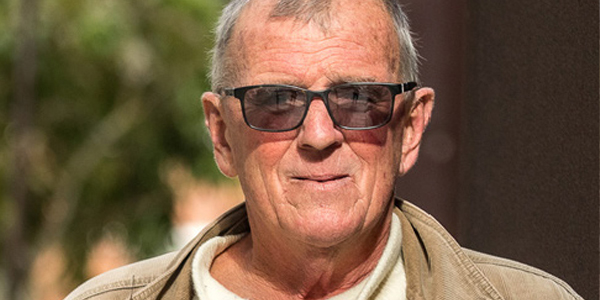
Honorary Life Membership
Honorary Life Membership is awarded to members in acknowledgement of loyal and outstanding service. This year, Bill Lenane (pictured, right) was elevated to an Honorary Life Member status. Bill has been a member of Hepatitis NSW since 2014. He was one of the original volunteers for our highly successful C-Me Community Advocacy Program which contributed to our advocacy to have hep C direct-acting antiviral treatments listed on the Pharmaceutical Benefits Scheme. As part of that advocacy, in 2015, Bill gave exceptionally powerful personal evidence at the first ever public hearing of the Pharmaceutical Benefits Advisory Committee. Bill credits Hepatitis NSW as having helped him to find meaning in his life – we have been repaid this ‘credit’ by Bill many times over through his outstanding contribution to the organisation in return.
Special Resolution – Hepatitis NSW Constitution
A Special Resolution to update the organisation’s Constitution was approved by at the AGM, will all members casting ballots, voting in favour. To pass, a Special Resolution requires at least 75% of votes in favour. The change to the Constitution modernised language, removed inconsistencies, and ensured compliance with the NSW Associations Incorporation Act. Major changes included:
- Updating the definition of purpose (“objects”) to more accurately reflect what Hepatitis NSW does.
- Improving dispute resolution rules.
- Amending the section on Board Members to better ensure diversity in experience, skills and characteristics to enable the Board to better fulfil its strategic and governance roles.
- Lengthening Board member terms to two years, to ensure continuity in governance.
Hepatitis NSW engaged a leading law firm specialising in NSW incorporations law to advise on the changes needed and to update our Constitution.
Updated Hepatitis NSW Constitution>>> CLICK HERE
Hepatitis NSW Board
Following the 2021 Annual General Meeting, the following people will sit on the Hepatitis NSW Board for the next two years:
- Denise Jarratt – President
- Jae Kang – Vice President
- Satyajit Patra – Treasurer
- Keziah Bennett-Brook
- Kurt Brereton
- Alex Chidzey
- Maurice Giacche
- Tracey Jones
- Sally-Ann Joseph
- Joe Lawler
- Carol Liu
- Rengen Parlane
- Alex Southcott
Celebrating hep B stories and lived experiences

At an early December lunch event in Parramatta, our Hep B Project Officers – Mina and Shan – brought together many of the writers and winners from the July 2021 Chinese and Korean Hep B Writing Competition.
The people attending had not met one another before, but have recently read each other’s stories on our hepB.org.au website.
This lunch brought together a group who were really glad that they had shared their stories and history of living with hep B. They all had experienced misinformation, and the harm of stigma as it had played out in their own and other’s lives.
They expressed a great relief and pride at having taken the step to send in their story, and in coming out to meet up. For some, hepatitis B has been a secret that they’ve struggled with, as misinformation had made their life options seem narrow or impossible. Migration and access to the Australian health system has made quite a difference to their sense of hope, and confidence about choices.
The atmosphere was relaxed and yet focused, as questions, ideas, experiences and breakthrough moments were exchanged. Basically, everyone had a lot to say! Shan and Mina truly had a ‘working lunch” as they provided information, current accessible pathways to treatment and shared ways of talking with others about hep B.
The group plan to do more for others and one another in the future. It was a wonderful moment for Hepatitis NSW to see a community support group forming- there are many people who will benefit over time.



